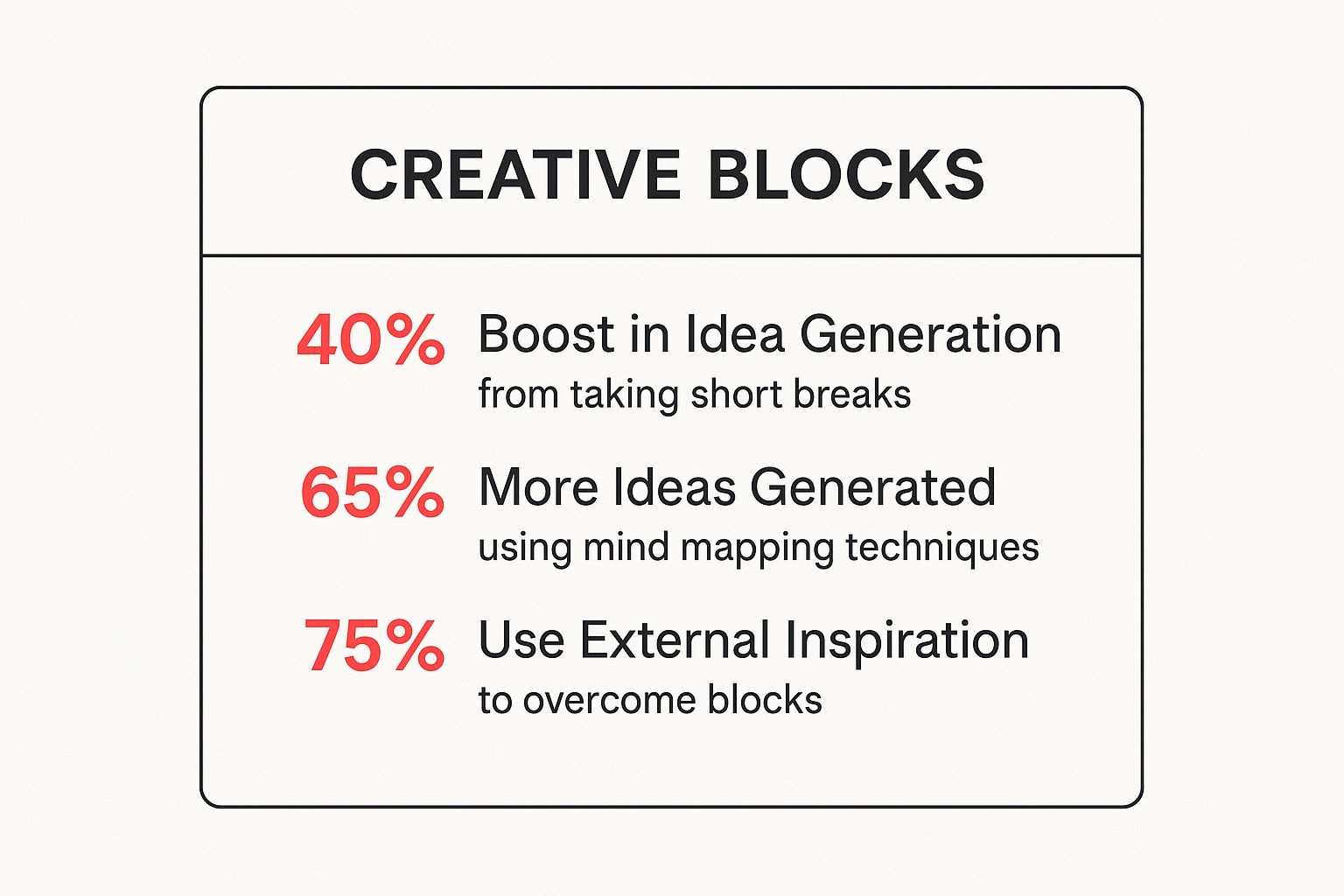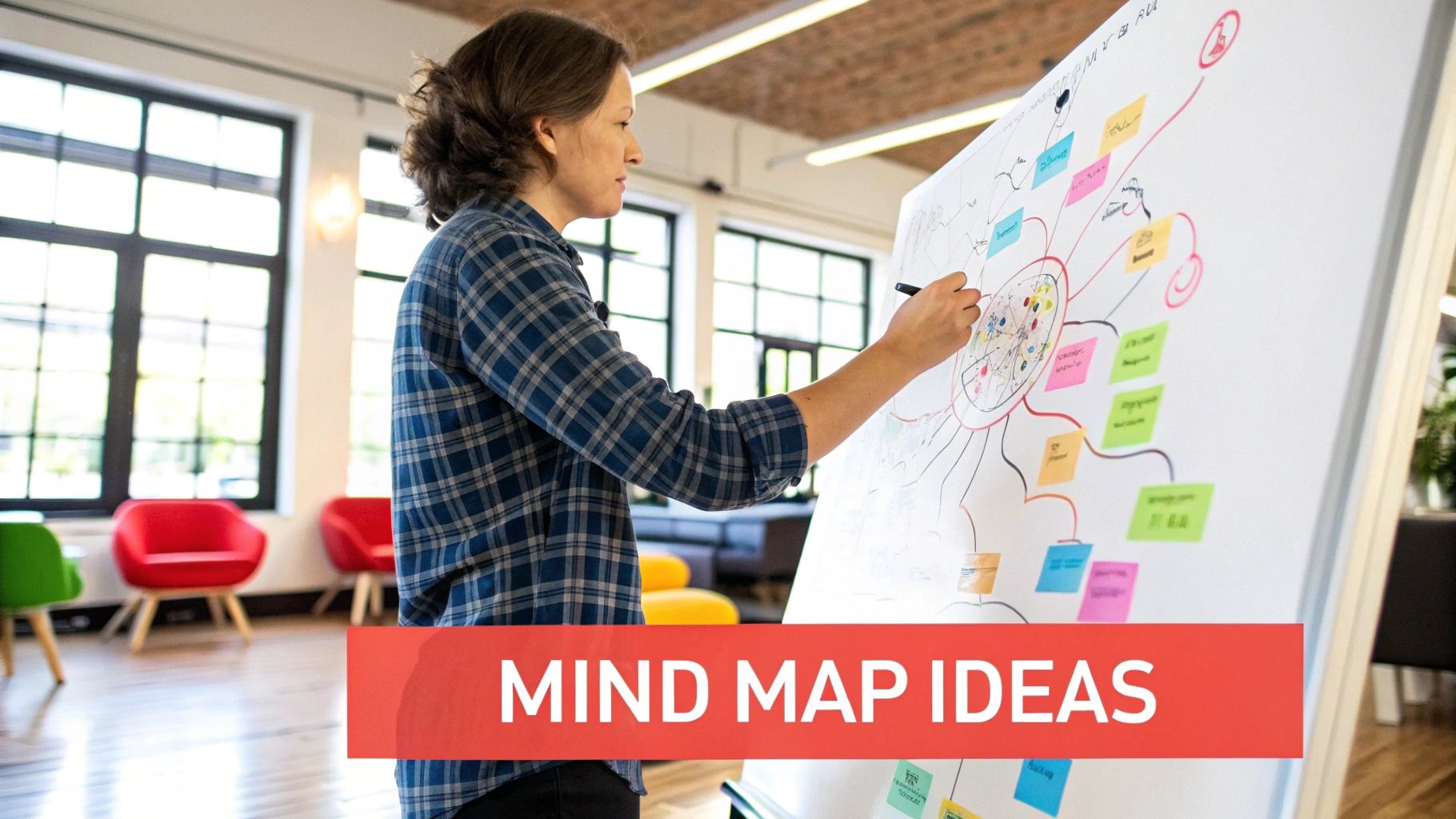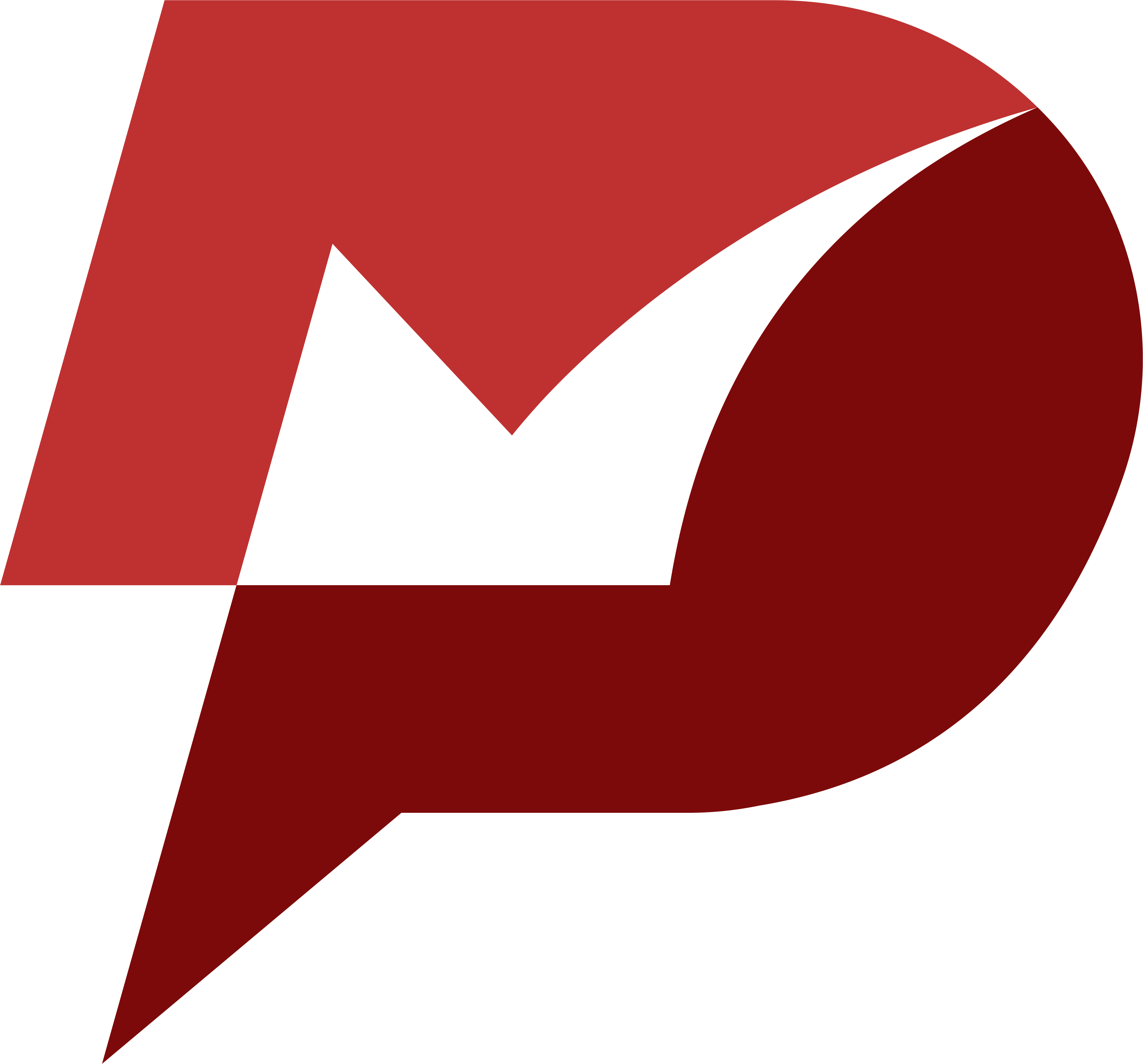We’ve all been there—staring at a blank screen, the cursor blinking mockingly. It feels like hitting a brick wall. When that creative inertia sets in, the absolute fastest way out is to take one tiny, immediate action.
Forget about creating a masterpiece. Your only goal right now is to make a mark, any mark, just to get your brain moving again.
Your First Step to Break Creative Inertia
The pressure to produce something brilliant right out of the gate is what paralyzes us. It's the "blank page syndrome." So, instead of trying to be perfect, we need to jolt our minds out of that frozen state with something simple and low-stakes. It’s about reminding your brain what it feels like to create without judgment.
A fantastic exercise I always come back to is the "Five-Minute Brain Dump." Seriously, set a timer for just five minutes. For those five minutes, you write, sketch, or list anything and everything that comes to mind about your project. The only rule? You can't stop until that timer dings. It forces action and effectively silences that pesky inner critic.
Identify the Block for a Quicker Fix
To get unstuck even faster, it helps to know why you're stuck in the first place. Are you mentally exhausted? Afraid of what people will think? Or just plain bored with the topic? Different problems respond better to different solutions.
Think of it like being a detective for your own creativity. A little diagnosis can point you toward the most effective quick fix.
Quick Fixes for Different Types of Creative Block
Here’s a simple table to help you figure out what's holding you back and what tiny action you can take right now to break the cycle.
| Type of Block | Primary Cause | Immediate Action |
|---|---|---|
| Perfectionism Block | Fear of not being good enough | Do the "Five-Minute Brain Dump." Focus on quantity over quality and give yourself permission to create junk. |
| Exhaustion Block | Mental or physical fatigue | Step away completely for 15 minutes. Take a walk, stretch, or do something totally unrelated to your project. |
| Fear Block | Anxiety about failure or judgment | Write down the absolute worst-case scenario. Seeing your fears on paper often shrinks them down to a manageable size. |
| Boredom Block | Feeling uninspired or repetitive | Change one small thing. Switch your tool (pen vs. keyboard), your location (desk vs. coffee shop), or the music you’re listening to. |
Matching the right action to the root cause makes a huge difference. You wouldn't try to brainstorm your way out of burnout, right? You’d take a break.
The data actually backs this up. Small, strategic shifts in how we work can have a massive impact on our creative output and consistency.

There's a clear pattern here: successful creators don't just wait for inspiration. They actively use external ideas, structured thinking exercises, and strategic breaks to keep the engine running.
The key takeaway is that overcoming creative block is an active process, not a passive one. You don't wait for inspiration to strike; you create the conditions for it to appear.
Sometimes, breaking through is about more than just a single exercise; it's about refining your entire workflow. You can find some great ideas on how to boost productivity that apply just as well to creative work as they do to coding.
By making one small, deliberate move, you shatter the cycle of paralysis. That little bit of momentum is often all you need to get back on track and tackle the real work.
Shift Your Mindset from Fear to Experimentation

Let’s be honest. That feeling of being totally stuck? It’s rarely about a true lack of ideas. It’s fear. It's the pressure we put on ourselves to create something incredible right out of the gate, which ironically ensures we create nothing at all.
The real trick to learning how to overcome a creative block is to stop seeing it as a performance and start treating it like a playground. You need to reframe that fear into a spirit of pure experimentation. Think of every attempt not as a final, graded project, but as a small, low-stakes test. Each piece of content, whether it soars or flops, is just a data point. It's valuable information that tells you what to do next. This simple mental flip from judgment to discovery can feel incredibly liberating.
Embrace Process Over Perfection
A practical way to make this happen is to focus on process-based goals instead of getting hung up on the final outcome. The pressure immediately starts to melt away when your only job is to show up and mess around for a little while.
-
Instead of: "I have to write a perfect blog post intro."
-
Try this: "I'm going to write for 15 minutes without hitting the backspace key."
-
Instead of: "I need to design a final, client-ready logo."
-
Try this: "I'm going to sketch 10 rough logo concepts in the next 30 minutes."
See the difference? This approach makes the massive task of "creating a final product" feel manageable. Your success isn't measured by how good the first draft is, but simply by the fact that you did it. You build momentum and creative confidence with every small session, which makes it so much easier to keep the ball rolling.
Make Friends with Failure
The most successful creators and brands don't run from failure; they build a system that expects it and learns from it. This is a surprisingly rare approach. One study on creativity found that only 13% of creatives felt their companies were friendly to taking risks. Worse, 29% admitted their workplaces were highly risk-averse.
This fear of trying bold new things is a direct cap on growth. Brands that are willing to take creative risks actually generate four times higher profit margins than their more cautious competitors. You can dive deeper into this fascinating connection between risk and reward in the full State of Creativity report.
As an individual creator, adopting a risk-friendly mindset is your secret weapon. While bigger players are playing it safe, you can be the one experimenting and figuring out what your audience really wants to see.
When you start treating failure as feedback, it stops being a painful verdict and becomes a powerful tool. Did that last video get almost no engagement? That's not a failure; it's data. Dig in and ask why. Was it the hook? The topic? The format? Every "miss" is a lesson that makes your next shot that much better.
Quieting Your Inner Critic
Your inner critic—that nagging voice telling you your idea isn't good enough—thrives on perfectionism and fear. And experimentation is its kryptonite.
When you're just "trying something out," the stakes are incredibly low. There's no pressure for it to be a work of genius on the first go. This gives you the freedom to be playful, curious, and a little weird... which is exactly where the best ideas are hiding. By consistently choosing experimentation over perfection, you'll start to quiet that critical voice for good and build a creative practice that's resilient and, most importantly, sustainable.
Practical Exercises to Refill Your Creative Well
Let’s be honest, staring at a blank screen trying to think your way out of a creative block is a special kind of torture. The very tools that are supposed to help us create—our keyboard and monitor—suddenly feel like the enemy. Sometimes the best thing you can do is simply walk away and engage your brain (and body) in a totally different way.
These aren't just empty distractions. Think of them as strategic retreats, designed to bypass that loud, critical voice in your head and give your creative spirit some room to breathe.
Take Yourself on an Artist's Date
I first learned about the "Artist's Date" from Julia Cameron's book The Artist's Way, and it's been a game-changer for me. It’s incredibly simple: block out an hour or two each week to go on a solo adventure somewhere that sparks your curiosity.
This has nothing to do with being productive. The whole point is to fill your well with new sights, sounds, and experiences.
- Get lost in a museum you’ve always meant to visit.
- Wander through a quirky antique shop.
- Take a long walk through a botanical garden or a part of town you don't know well.
- Grab a coffee in a new neighborhood and just people-watch.
The only rule? You have to go alone. This makes the experience entirely yours, free from anyone else's agenda or opinions. You’re just there to absorb.
Practice Stream-of-Consciousness Writing
Another powerful exercise, also from Cameron, is what she calls "Morning Pages." The idea is simple but surprisingly effective. First thing in the morning, before you do anything else, you sit down and write three pages by hand. It's a pure stream-of-consciousness brain dump.
Don't edit. Don't censor. Don't even worry if it makes sense.
The goal isn't to create good writing. It’s to get all the mental clutter—the anxieties, the to-do lists, the random junk—out of your head and onto the page. Doing this clears up so much mental space for the real creative work you need to do later.
It's a fantastic way to silence your inner critic because you're moving too fast for it to keep up. This practice often taps right into your subconscious, unearthing ideas you didn't even know were there.
This kind of low-pressure creation can become a goldmine for future projects. While many of us are focused on visual content, this foundational process is universal. In fact, some of the most successful creators have built entire brands by sharing their unique creative process, which is a great lesson in how to earn from social media with authentic content.
Use Object Doodling to Find New Perspectives
This one is just plain fun and requires nothing more than a pen, paper, and a random object. Grab something ordinary off your desk—a paperclip, a coffee mug, your keys. Now, spend 10 minutes doodling it, but here's the twist.
Transform that paperclip into a monster or a rollercoaster. Imagine your coffee mug is a tiny spaceship or a portal to another dimension. You're forcing your brain to look at something familiar and see something completely new. It's a great way to break out of rigid thinking and remember that creativity is often just about making unexpected connections.
These exercises should feel like play, not work. By regularly stepping away from the pressure to perform and engaging in these kinds of restorative practices, you'll build a deep well of inspiration to draw from when you need it most. If you're looking for even more ways to get the juices flowing, check out these 10 innovative ways to ignite ideas.
Use Volume to Break Through Stagnation

When you feel completely tapped out and fresh ideas have evaporated, the best solution can feel totally backward. It's not about waiting for that one brilliant spark of inspiration. The secret is to simply create your way out of the slump.
This means you need to temporarily shift your focus from quality to quantity.
Think about it. The pressure to make every single piece of content a masterpiece is crippling. It turns creating into a high-stakes performance. But what if you saw your work as a series of quick, small experiments instead? By aiming for volume, you lower the pressure on any single piece, which ironically gives you more chances to strike gold. This is how you can actively dismantle a creative block and turn it into a process of discovery.
Adopt a Production-Focused Workflow
The goal here isn't to create more junk; it's to create more opportunities for a hit.
Start by giving yourself a simple, production-based goal. Instead of trying to nail one perfect video this week, challenge yourself to film five short, experimental clips. The new objective is just to create, test, and learn. This takes so much of the emotional weight off your shoulders. A video that flops is no longer a failure—it’s just a data point that helps you figure out what to try next.
And this isn't just a feel-good theory; it’s a proven, data-driven path to success. A case study comparing two brands found that Brand A, which created 10 pieces of content a month with a 30% success rate, ended up with a cost of $1,667 per successful creative.
Brand B, on the other hand, churned out 100 pieces a month. Even with a much lower 10% success rate, their cost per hit was only $500. By embracing a higher volume, Brand B was far more efficient and profitable, even with more "misses" along the way. You can dig deeper into these creative performance metrics that lead to faster growth.
Tracking Your High-Volume Output
For this to work, you need a simple way to track what’s actually connecting with your audience. Don't get lost in a sea of complicated analytics. Just watch for a few key signals.
Here are a few things to keep an eye on:
- Engagement Spikes: Did a specific video get a surprising number of comments or shares? Make a note of the topic, hook, and format.
- Audience Questions: What are people asking in the comments? This is a goldmine for your next batch of content ideas.
- Watch Time: Which videos hold people's attention the longest? That tells you what your audience genuinely finds interesting.
By prioritizing volume, you stop waiting for inspiration and start manufacturing it. You take so many shots on goal that you’re bound to score, turning stagnation into a powerful engine for growth and consistent output.
Navigating Tough Times: How to Stay Creative When the World is Stressful

Let's be real. Sometimes creative block has nothing to do with you and everything to do with what’s happening outside your window. When the economy is shaky or the industry hits a slowdown, that stress can seep into your work and shut down your creativity completely.
Financial worries are a huge creativity killer. In fact, many creators are facing the toughest market since the 2008 financial crisis. I’ve heard from freelance designers who have gone months without a single project, and even large, established production companies are feeling the squeeze. When resources are tight and the pressure is on, it’s no wonder your brain just wants to freeze up. You can read more about how creatives are surviving the current slowdown on Creative Boom.
But you don't have to let the outside world dictate your creative drive. This is where resilience comes in. It’s your best defense against the storm.
Do More With Less
When budgets get slashed and big opportunities dry up, it’s easy to feel paralyzed. The pressure to make every single project a massive success can be overwhelming. The trick is to get scrappy and shift your mindset to doing more with less.
Instead of trying to hit a home run with one perfect, polished project, start thinking in smaller, faster experiments. Can you whip up some short-form videos with just your phone? Could you repurpose a blog post into a carousel or a Twitter thread? This approach lowers the stakes and, most importantly, keeps you in the habit of actually making things.
Find New Pockets of Opportunity
Relying on one skill or one source of income is always a bit risky, but that risk is magnified during a downturn. This is the perfect moment to diversify.
Think about skills that are adjacent to what you already do. If you're a graphic designer, maybe it’s time to learn some basic motion graphics. If you’re a writer, could you dip your toes into social media management?
Building a diverse skill set not only makes you more marketable but also opens up new creative avenues you might not have considered, helping you overcome a creative block by simply trying something new.
Diversifying your income is just as critical. Exploring different platforms can create a financial cushion when your main gig is slow. Many creators have found success by looking for new ways to get paid online. If you're looking to branch out, this guide on how you can get paid on social media is a great place to start looking for new ideas.
Building a strong professional and mental foundation is how you weather these storms. Here’s what you can do right now:
- Lean on Your Network: Get in touch with other creatives. Seriously. Sharing your struggles and brainstorming solutions with people who get it is invaluable. It's good for your mental health and can even lead to new work.
- Be Realistic: Don't beat yourself up for not being as productive as you were when times were good. Acknowledge the stress you're under and give yourself some grace. Your main goal is to avoid burnout.
- Guard Your Mental Health: Make time for whatever helps you de-stress. Whether that's hitting the gym, meditating, or just going for a walk, prioritize it. Your well-being is the fuel for your creativity.
By focusing on these resilience strategies, you can keep your creative spark alive, even when things get tough.
Let's Talk About Creative Block: Your Questions Answered
Even when you're armed with a bunch of strategies, it's easy to get stuck on specific questions when you're right in the middle of a creative slump. Let's dig into some of the most common worries that pop up when you're trying to figure out how to get past a creative block.
How Long Does Creative Block Usually Last?
This is the million-dollar question, isn't it? The honest answer is that there’s no single timeline. A creative block can be as short as an afternoon or drag on for what feels like an eternity.
A minor snag, maybe from being tired or a little distracted, might clear up in a few hours or after a good night's sleep. But a deeper block, one that’s tied to serious burnout or a crisis of confidence, could stick around for weeks, even months. The key isn't to just sit there and wait for inspiration to strike. The more you actively try different tactics—getting out of the house, trying a new exercise, or just switching gears—the faster you'll break through it.
Is Creative Block a Sign I Should Quit My Project?
It's so easy to let this thought creep in, but 99% of the time, the answer is a firm no. Think of a creative block less as a "Game Over" screen and more as a helpful alert from your brain. It's usually telling you that your current approach has run its course or that you're too close to the project to see it clearly.
It's a completely normal part of making anything new. Instead of throwing in the towel, see it as a signal to take a strategic pause. Step away, do something totally unrelated for a day or two, and then come back to your project with a fresh set of eyes. It’s just an obstacle, not a dead end.
Can Changing My Tools Help Overcome a Block?
Oh, absolutely. It sounds almost too simple, but switching up your tools can work wonders. If you always type on a laptop, try grabbing a pen and a notebook. If you're a digital artist, try a different brush pack or even some old-fashioned charcoal. This little bit of novelty can be just the jolt your brain needs to get out of its rut.
Just a small word of warning here: don't let the search for the perfect new tool become another form of procrastination. The point isn't to find some magical solution, but to introduce a tiny, manageable change to your routine. For creators, this can even mean changing your workflow tools. Knowing how to schedule TikTok posts can take the pressure off daily posting, freeing up mental space to just create.
It's really important to know the difference between a creative block and full-blown burnout. A block is usually about the work itself—you just can't come up with the next idea. Burnout is a much deeper exhaustion that affects everything. Burnout will always cause a creative block, but not every block is caused by burnout.
If you're feeling cynical and drained by everything, not just your project, you might be dealing with burnout. That calls for real rest and recovery, not just another brainstorming exercise. For more on topics like this, the Meowtxt Blog often has some great perspectives.
Ready to skip the slow grind and start earning from your content right away? MonetizedProfiles provides monetization-approved TikTok and YouTube accounts that are organically grown and ready to generate ad revenue from day one. It's the perfect way for content creators to bypass the initial hurdles and focus on what they do best: creating. Check out our available accounts at https://monetizedprofiles.com.








